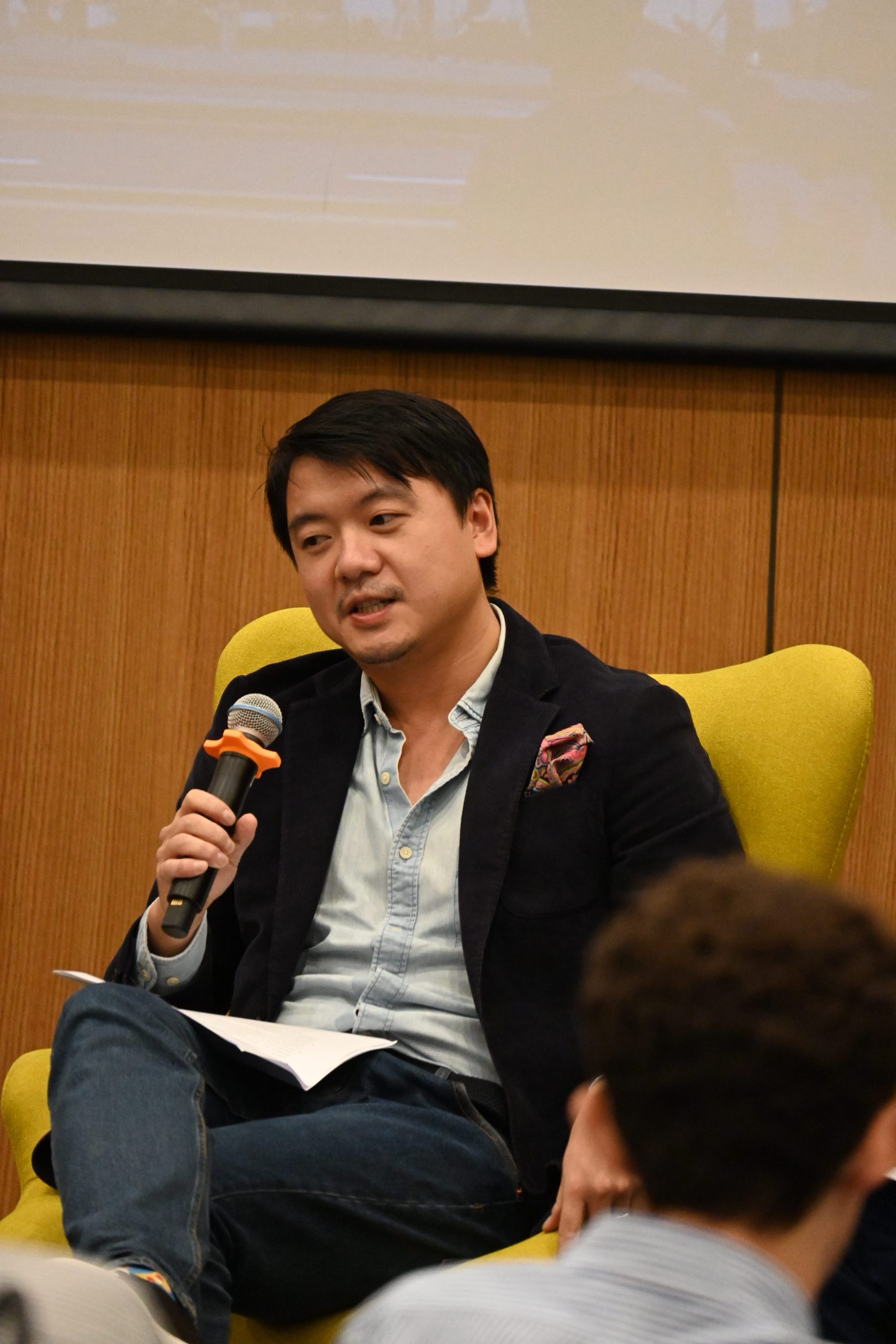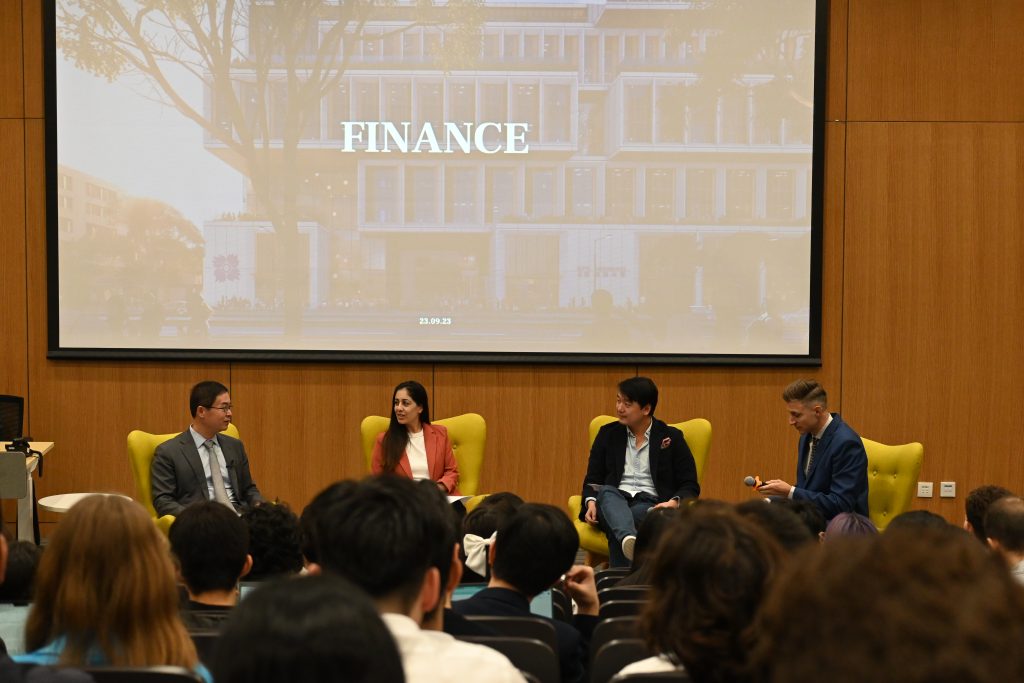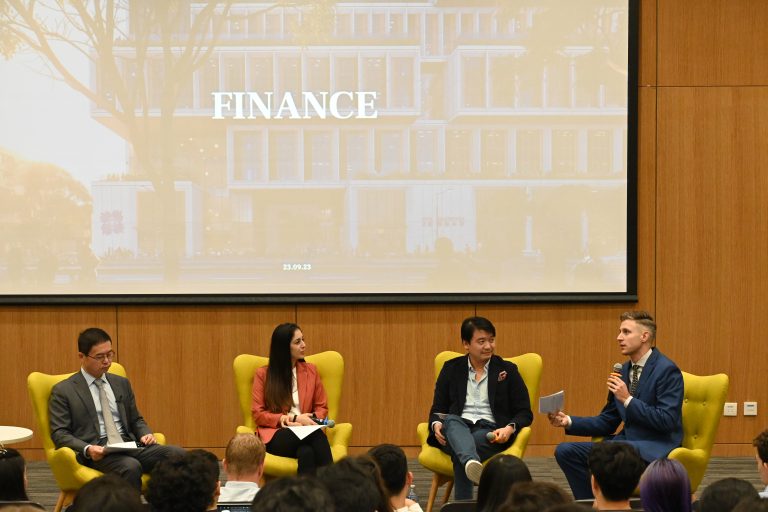The following article is the second part in a five part series…
Pudong New District, Shanghai
DKU’s Finance Club travelled to Shanghai for a day of learning from industry experts on economics, finance and doing business in China last month. Titled the “Chamber of Commerce” weekend, the event was held at NYU Shanghai’s new Qiantan campus in Pudong New District by NYU Shanghai’s Economics Society, the NYU Shanghai Economics Department and the Tamid Group at NYU Shanghai.
An all-day panel, the event featured five panels including: supply chains and manufacturing, finance, technology, trade and infrastructure and real estate. With a special centering on China’s financial capital of Shanghai, the Sep. 23 event gave students the latest information and analysis on each respective topic from experts who had weathered the Covid-19 pandemic.
The speakers at the event included NYUSH professors, business professionals and representatives from multiple chamber of commerce organizations located in Shanghai including the American Chamber of Commerce, Israeli Chamber of Commerce and the Swedish Chamber of Commerce. A question and answer session followed each panel conversation in addition to a chance to meet and chat with panel experts.
Each panel was held in a large lecture hall while breaks between the sessions allowed students to continue conversations with the experts or explore the NYUSH Qiantan campus.
Panel 2/5: Finance
The finance panel, moderated by Ilaf Elard, Assistant Professor of Economics at NYUSH, featured three speakers including Cheng Ye, Chair of the Financial Services Committee at the American Chamber of Commerce (AMCHAM), and China Country and Shanghai Branch Manager at Wells Fargo, Ya’el Farjun, an entrepreneur and China Business Development, Partnerships and Marketing Manager at PTL group, and Tony Wang, Vice Chairman of the Swedish Chamber of Commerce in China (SWEDCHAM) and a Partner at Nordic Match, an M&A and Strategy Advisor, focusing on “Sino-Nordic” transactions.
Historical Development of China’s Financial System & Emerging Challenges
Beginning with a round of self-introductions, Tony Wang, outlined the history of China’s developing financial industry in relation to his own business experience in China. Upon his arrival to China in 2013 as a currency trader with a Swedish Bank, China was still in its “infant stage,” Wang asserted, with its financial industry still “relatively new.”

Highlighting China’s growth into the world’s second largest market in the last decade, Wang contrasted the fledgling Chinese market with the over 200-year-old US financial system at the time of his arrival.
Along with the sentiment of the developing nature of China’s financial system, Wang proceeded to outline the challenges facing the contemporary financial system and economy.
Capped investment from foreign limited partners, pension funds and general partners that employ capital on behalf of pensioners was the first issue Wang raised, explaining that the lessening capital flows into China pose limits to Chinese financial markets.
With entrepreneurs of the ‘80s and ‘90s retiring, upsets and opportunities are present for future and contemporary China, Wang asserted. With old talent going out, new talent coming in, the consolidation of firms could be an immediate by-product of leadership changes in the Chinese economy.
When asked about the mergers and acquisition (MMA) opportunities for foreign firms in the new economy, pros and cons exist for both foreign and domestic actors, the SWEDCHAM chair responded. Contrasting the ruthless ‘dog-eat-dog’ nature of Chinese business competition, opportunities are presented to foreign firms given their historical experience with MMA deals. Chinese companies do not have the MMA experience that foreign firms have according to Wang, whereby domestic Chinese firms would rather outcompete competitors rather than be bought up by a larger firm.
Progress & the Need for Further Financial Liberalization
Concerning financial liberalization, while Wang pointed towards China’s progress in recent years and positive trends, the other panelists painted a more pessimistic picture, citing an increasingly regulated financial landscape and continued barriers to China’s financial connection to the outside world.
“What happens in China, stays in China,” is how Ya’el Farjun, Israeli entrepreneur and longtime Shanghai resident, characterized the modern Chinese financial system.

Although becoming advanced overtime, the liberalization of China’s financial system has not followed the same pace, Farjun explained. A “closed system” from the rest of the world, Farjun described the barriers to companies doing business in China.
Highlighting China’s domestic “fapiao system,” (China’s domestic invoicing system) Farjun explained how the system does not apply to anywhere outside of mainland China. Beginning with foreign firms moving money into China, the panelist stated how a firm must first send their funds to a domestic Chinese counterpart in order to do business in the mainland.
Once the money is in the mainland, the domestic Chinese counterpart issues a fapiao (recording the transaction in the domestic tax bureau system), and from there the company can conduct domestic transactions.
Describing an increasingly regulated environment, Farjun explained how unlike the past, all transactions coming into the country today have to be detailed and explained to the relevant authorities.
Due to the closed nature of the mainland Chinese financial system, companies “strategize accordingly,” making sure they maintain enough revenue to conduct their domestic operations.
Regarding domestic transactions, Farjun explained that unlike the convenient customer-to-customer (C2C) transactions involving the simple scanning of QR-codes, business-to-business (B2B) transactions must be conducted via what the speaker termed as the “archaic” system of bank wiring.
Shanghai: A Financial Center in Asia?
Cheng Ye, the Financial Services Committee Chair at AMCHAM, centered the conversation around the basics of financial liberalization and China’s measuring up to those standards.

Referencing an AMCHAM paper titled “2022 Shanghai: The Financial Center of Asia,” that he wrote in 2018, Ye gauged the audience as to whether Shanghai had achieved the status as an Asian financial center.
Professor Elard, providing his own response to the question, claimed yes, on the basis of “its stock market and bond market,” but no, “in the sense of being a rival to Singapore.”
“To be a true financial center for either Asia or the world, you have to have the free flow of three things: the free flow of information, the free flow of capital and the free flow of people.”
Cheng Ye, financial services committee chair at the american chamber of commerce in shanghai
Ye asserted that a “true financial center” must maintain the free flow of three things, including information, capital and people. Contrary to the optimistic title of the AMCHAM project he participated in years prior, Ye explained that no mainland Chinese cities have yet achieved these standards.
However, Ye pointed towards significant liberalization moves in recent years, including Chinese regulators approving foreign-owned insurance companies and banks to establish fully-owned subsidiaries in China, what he characterized as “a big step forward.”
Citi Group became the first US bank to obtain a “domestic fund custodian license” in 2020, giving the firm access to domestic Chinese mutual funds, Ye stated.
Furthermore, Standard Charter became the first foreign bank to trade treasury bond futures earlier this January, Ye continued, signaling a push by Chinese regulators to open up Chinese capital markets in the face of capital outflow this past year.
Labeling the approval of the Standard Charter deal as a “breakthrough,” the issuing of the license to trade the security marked a serious step along the path towards foreign companies directly accessing China’s capital markets, Ye asserted. Prior to the deal, companies were required to partner with a state-owned enterprise (SOE) to obtain access to Chinese capital markets, Ye explained.
“This is very important to Shanghai and to all of China, because if we don’t get the numbers this year, for foreign direct investments for the first eight months of 2023, that is 5.1 percent down compared to the same period last year,” Ye explained.
Ye’s floating of the 5.1 percent down foreign direct investment (FDI) figure in the first eight months of 2023 raises eyebrows, with Ye pointing out that figure is based off October 2022 where the Covid pandemic had already left FDI at dismal levels.
Highlighting China’s rising economic and financial woes with foreign direct investment down significantly since the same time the year prior, Ye called for the need for liberalization to speed up to stem China’s slowing economy.
Circling back to Farjun’s discussion of an increasingly regulated domestic business environment, Ye explained that the rise in domestic transaction scrutiny is due to a recent push by the People’s Bank of China (PBOC) to crack down on money laundering.
With Ye’s calling for greater liberalization and the simultaneous rise state-oversight in the economy, China’s developing economic slump will push the envelope regarding the regulatory path the nation takes in the foreseeable future.
Q & A Session
In the question-and-answer section following the panel, the speakers responded to a variety of questions touching on a range of topics including practical advice for doing business in China to current foreign investment behavior in China.
“How does Shanghai balance the need for financial innovation and attracting foreign investment with the necessity for maintaining financial stability and the need for financial control?”
In contrast to her calls for liberalization in her prior panel talk, Farjun, a long time entrepreneur in Shanghai, asserted Shanghai is the
Despite her calls for liberalization in the prior panel conversation, Farjun, a long time entrepreneur in Shanghai responded to the question calling for entrepreneurs to set up shop in the city.
Although not the same as it was prior to the Covid pandemic, Shanghai still remains the best place in China for innovation Farjun asserted, with Beijing’s area around Tsinghua University also taking a leading role.
It is “relatively easy to open a firm” in Shanghai, Farjun asserted. Beginning with the ease of access to capital and investment in the city in addition to other favorable features including the presence of incubators and government incentives, Farjun highlighted the waiving of work visa requirements for those who obtained degrees from Shanghai universities.
Working with the Regulators
A manager of Wells Fargo in China, Ye was asked about his experience in dealing with Shanghai and China’s financial regulatory institutions.
Providing a story from his own experience, Ye articulated developments in the domestic regulatory environment where the basic relationship between the regulated and the regulators has changed over time.
Meeting with the China Banking and Insurance Regulatory Commission (CBRC) weekly in his capacity as the China Country Manager and Shanghai Branch Manager at Wells Fargo, Ye described a change in the financial regulatory experience over the past ten years where regulators have taken up a more service-oriented role to maintain and expand foreign financial ties.
Now known as the National Administration of Financial Regulation (NAFA) as of March this year, Ye opined how working with the body a decade ago could be described as a student meeting with a teacher, where the student must accept the teacher’s orders.
Today, the same regulatory body is “acting as a service provider,” Ye explained. The panelist described how the CBRC (now NAFA) central office travelled to Shanghai last year to meet with the heads of 20 foreign banks. Having Shanghai CBRC branch representatives step out of the room during the meeting, the chief regulators asked the foreign bank representatives directly as to how they could be better served in Shanghai and across the country.
“They will try to tell you that they are the service provider, they want foreign financial institutions to succeed, because… foreign direct investments have declined. Now there is an urgency from the Chinese government regulators to be acting more like a service provider to not only foreign financial institutions but foreign companies and start-ups,” Ye stated.
Ye asserted his story and the shift in regulators’ attitudes is a sign of China’s desire to draw in foreign investment, especially following the capital flight following the Covid-19 pandemic and recent geopolitical headwinds.
Headlines vs. On the Ground Observation
In contrast to the pessimistic headlines of capital flight out of China, SWEDCHAM chairman Wang stated money managers are coming to China looking for opportunities as others pull out of the market.
“While you can see that there’s a lot of money going out of China -that’s what you read in the Financial Times, Wall Street Journal, etcetera, etcetera. But if I observe on the ground, there actually are money managers, there are established businesses moving here deploying capital as well,” Wang explained.
What is read in the news and what occurs on the ground “can be slightly different,” Wang continued, stating that the reality of the situation lies “somewhere in between.” Wang called for the need for those involved and for observers to “keep an open mind,” to not believe everything they read and to form their own judgements.

